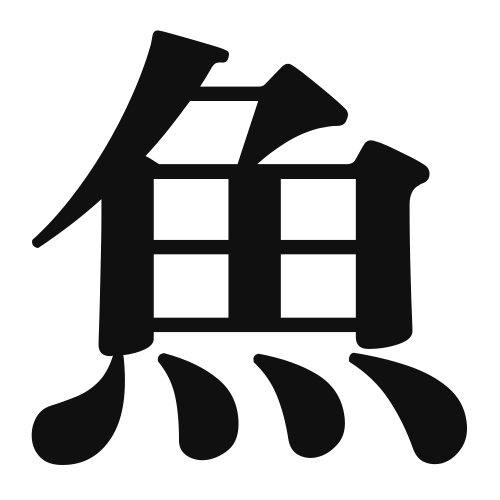1. Overview of Meaning
The kanji “魚” (pronounced “sakana” in Japanese) means “fish.” It represents aquatic animals that are commonly found in rivers, lakes, and oceans, and is a staple in many cuisines around the world.
2. Formation and Radical
Formation of the Kanji: The kanji “魚” is a pictogram, which means it visually represents the object it denotes. The character resembles a fish, capturing its shape and features.
Radical: The radical for “魚” is also “魚,” which is used in other kanji related to fish and aquatic life, emphasizing its thematic connection.
3. Examples of Usage
Common Words and Phrases: Some frequently used words that include the kanji “魚” are:
- 魚料理 (sakanaryouri) – fish dishes
- 魚市場 (uoiichiba) – fish market
- 魚釣り (uotsuri) – fishing
Example Sentences in Daily Conversation:
- 今日は魚を食べたいです。 (Kyou wa sakana o tabetai desu.) – I want to eat fish today.
- 魚市場に行きました。 (Uoiichiba ni ikimashita.) – I went to the fish market.
4. Synonyms and Antonyms
Similar Kanji: A similar kanji is “鮮” (sen), which means “fresh” and is often used in the context of fresh fish (鮮魚, sen’gyo).
Antonyms: An antonym could be “肉” (niku), which means “meat,” referring to land animals, contrasting with “魚” which refers to aquatic animals.
5. Cultural and Historical Background
Connection to Japanese Culture: Fish plays a significant role in Japanese cuisine, with dishes like sushi and sashimi being popular worldwide. The kanji “魚” is often associated with freshness and quality in food.
Proverbs and Idioms: One common Japanese proverb is “魚心あれば水心” (Uo-gokoro areba mizu-gokoro), which translates to “If you have a heart for fish, the water will respond,” meaning that mutual understanding is essential in relationships.
